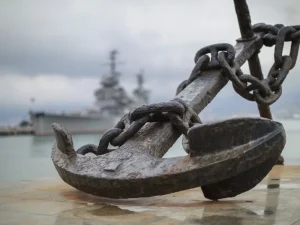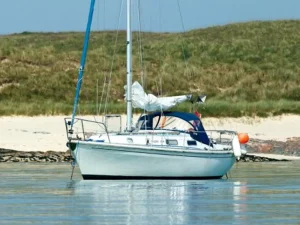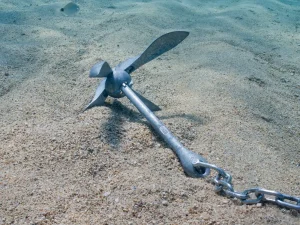Schepen en vaartuigen gaan vaker voor anker om stabiel in het water te blijven liggen. Deze praktijk garandeert de veiligheid van schepen tijdens zware weersomstandigheden. Voor anker gaan is echter niet zo eenvoudig als het lijkt. Kleine fouten kunnen leiden tot verkeerd ankeren. Daarom is het heel belangrijk om te weten wat je moet vermijden als je voor anker gaat.
Heb je wel eens gehoord van mislukte ankerpogingen? Dat gebeurt wanneer een schip of vaartuig niet goed ankert. Het gevolg is dat het blijft bewegen of afdrijven in plaats van op één punt te blijven. Snel en correct ankeren is waar elke scheepsloods van houdt. In dit artikel leer je welke fouten je moet vermijden om soepel te kunnen ankeren. Dus laten we beginnen!
Overzicht van verankeren en het belang ervan

Ankeren is het proces dat schepen vertonen om stabiel op één positie in het water te blijven. Dit gebeurt door een anker (gemaakt van metaal) in het water te gooien. Dit anker grijpt zich vast in de zeebodem. Dit grijpen van het anker zorgt ervoor dat het schip niet afdrijft of beweegt als gevolg van watergolven of wind.
Met behulp van ankers kunnen schepen en grote vaartuigen overal in het water verblijven. Mensen willen bijvoorbeeld graag vissen. In dergelijke gevallen kan de schipper de boot verankeren door een anker uit te gooien. Het anker blijft door middel van ankerlijnen (touwen of kettingen) aan de boeg van schepen bevestigd. Laten we eens bespreken waarom het juiste anker zo essentieel is:
- Ten eerste zorgt een goede verankering ervoor dat het schip stabiel blijft en niet wegdrijft.
- Voor anker gaan is essentieel als er meer dan één schip in het ankergebied ligt. Als je niet voor anker gaat, zal je boot in aanvaring komen met een ander schip door het afdrijven.
- Met behulp van ankeren kun je op elk deel van de zee of rivier blijven. Zonder anker zou je verblijf in zee wankel en onstabiel zijn.
- Voor anker gaan helpt als je te maken krijgt met zwaar weer midden op zee. Je kunt het schip gewoon voor anker leggen en wachten tot het weer rustig wordt. Je boot zal niet wegvaren door extreme wind. Als je niet voor anker gaat, kun je de controle over het schip verliezen in slecht weer.
Wat moet je vermijden bij het verankeren?
Het lijdt geen twijfel dat ankeren zeer nuttig is voor veilig reizen op zee. Er zijn echter veel dingen die het ankerproces kunnen beïnvloeden. Een kleine fout kan ertoe leiden dat het anker geen stevige grip krijgt op de zeebodem. In de volgende paragraaf bespreek ik deze veelvoorkomende fouten. Je moet deze fouten vermijden tijdens het ankeren voor betere prestaties en veiligheid.
1- Een ongeschikte verankeringsplek kiezen

Ten eerste moet je nooit voor anker gaan in gebieden met rotsen. Stel je bijvoorbeeld voor dat je je anker laat vallen op een plek waar de zeebodem rotsen bevat. In dat geval zal je anker geen goede grip hebben. Het gevolg is dat het schip blijft drijven door een gebrek aan grip. Onthoud dat ankeren draait om een stevige grip op de zeebodem.
Ik raad aan om je vaartuig in een modderig gebied te verankeren. Het anker zal stevig in de zeebodem grijpen en het schip stabiel en onbeweeglijk houden. Sommige delen van de zee hebben meer getijden en golven dan andere. Zoek daarom een gebied met minimale golven. Dit zorgt voor een soepel ankerproces.
2- Verkeerd type anker
Je moet nooit een anker gebruiken als je het niet kent. Dit is een bekend gezegde onder zeilers. Er zijn verschillende soorten ankers beschikbaar die specifiek zijn in hun functionaliteit. De Danforth ankers zijn bijvoorbeeld over het algemeen geschikt voor ankerwerk in modderige of zanderige gebieden.
Deze ankers werken niet als je ze gebruikt om je schip te verankeren op een harde of rotsachtige ondergrond. Aan de andere kant is het ploeganker ideaal voor het verankeren van boten op een rotsachtige ondergrond. Ze hebben puntige punten die snel in de rotsen graven en ervoor zorgen dat het schip niet afdrijft.
Daarom moet je het doel van elk anker begrijpen voordat je het gebruikt. Bovendien is de grootte van het anker ook belangrijk. Gebruik nooit een lichtgewicht anker voor een zware boot. Het zal niet genoeg kracht leveren om het vaartuig stabiel te houden. Omgekeerd is het ook niet aan te raden om een zwaar anker te gebruiken voor een kleine boot.
3- Een kleine of te lange ankerlijn gebruiken
De ankerlijnen zijn een cruciaal element in het verankeringsproces. De verkeerde maat van deze touwen of ankerlijnen kan leiden tot onjuiste verankering. Als je kortere ankerlijnen kiest, zal het anker niet diep genoeg gaan om de zeebodem vast te grijpen. Het zal dus niet voorkomen dat het schip afdrijft. Zelfs met een ankergreep zal er een steile hoek zijn.
Hierdoor kan het anker niet meer gewicht op het schip houden. Aan de andere kant moeten lange ankerlijnen ook worden vermeden. Ze kunnen onnodige weerstand en slingering veroorzaken, wat leidt tot instabiliteit. In het vorige artikel heb ik vermeld het kiezen van de juiste maat ankerlijn. Ik raad aan dat artikel te lezen voor een beter begrip.
Snel hoogtepunt: De ideale maat voor ankerlijnen is 5:1. Je moet een ankerlijn van vijf voet lang kiezen als je ankert op een waterdiepte van één voet. Als de weersomstandigheden zwaar zijn, gebruik je een reikwijdte van 7:1 of 9:1. De reikwijdte van 5:1 werkt echter prima in de meeste ankeromstandigheden.
4- Niet controleren of het anker houdt

Het lijkt misschien een klein foutje, maar het kan leiden tot een ernstig ongeluk. Je moet controleren of het anker goed vastzit of niet. Dit is nog belangrijker als je het schip voor anker legt op een druk ankerpunt. Als je bijvoorbeeld niet controleert, houdt het anker niet goed. Het schip zal dus blijven drijven.
De kans dat je schip in aanvaring komt met schepen in de buurt is groot. Daarom moet je altijd controleren of het anker nog goed zit voordat je vertrekt. Je kunt dit doen door de boot in de tegenovergestelde richting van het anker te bewegen. Als het anker aan het schip trekt, betekent dit dat het houdt, en andersom. Bovendien kun je dit controleren door kleine, consistente driften van schepen in één richting op te merken.
5- Het anker verkeerd laten vallen
Sommige mensen maken de fout om het anker snel uit te gooien. In zo'n geval komen het anker en de lijnen ervan snel in het water terecht. Zo kunnen ankers verstrikt raken in hun kettingen van ankerlijnen. Daardoor graaft het zich niet in de zeebodem in. Daarom raad ik aan om het anker rustig uit te gooien.
Hierdoor zal het soepel op de zeebodem neerkomen. Zodra het anker de zeebodem raakt, kun je de touwen loslaten. Zodra het anker de zeebodem raakt, moet je het schip lichtjes bewegen. Deze lichte beweging van het schip zorgt ervoor dat het anker grip krijgt op de zeebodem. Kortom, laat het anker niet overhaast vallen.
6- Vergeten de ankerlijn te markeren
Tijdens het ankeren moet je de ankerlijn of -touwen losmaken met het anker. Toch? De juiste lengte van de ankerlijn gebruiken is cruciaal. Ankerkettingen gebruiken Te kleine of te lange ankerlijnen kunnen leiden tot onjuiste verankering. Je kunt weten welke maat ankerlijn je moet gebruiken door een bereikverhouding van 5:1 te gebruiken.
Maar hoe weet je hoeveel touw je hebt losgemaakt? In dit geval komt het markeren van de ankerlijn van pas. Wanneer je de ankerlijn loslaat, moet je de lijn na een regelmatig interval markeren. Je kunt bijvoorbeeld elke 5 voet een kleur markeren op de lijn. Op deze manier weet je de juiste lengte van het touw dat je loslaat tijdens het verankeren.
7- Verlegen worden om een tweede anker te gebruiken wanneer dat nodig is
Correct ankeren is sterk afhankelijk van het weer. Helaas is het weer een oncontroleerbaar element in de scheepvaart. Toch? Daarom moet je altijd twee ankers aan boord hebben. Een enkel anker werkt prima in normale omstandigheden om de boot stabiel te houden. Soms gaat het weer echter tegen onze verwachtingen in.
De hoge golven en stromingen kunnen de schepen laten drijven. Een enkel anker faalt bij zulke sterke getijden. Als je je in zo'n situatie bevindt, aarzel dan niet om je tweede anker uit te gooien. Dit tweede anker zorgt ervoor dat je schip niet beweegt ondanks de extreme weersomstandigheden. Veel mensen zijn lui als het gaat om het laten vallen van het tweede anker.
8- Het anker aan de achtersteven vastmaken
Over het algemeen hebben schepen speciale punten waar je het anker kunt vastmaken. Dit punt bevindt zich op de boeg van de schepen. Maar kleine boten hebben geen speciale markeringen voor het vastmaken van het anker. Dus maken nieuwelingen de fout om het anker aan de achtersteven (achterkant van het schip) vast te maken.
Dit is een verkeerde praktijk omdat het onbalans kan veroorzaken. Vergeet niet dat het achterschip kwetsbaar is en het gewicht en de trekkracht van het anker niet aankan. Vermijd daarom het gebruik van een achtersteven om het anker vast te maken. De boeg van kleine tot grote boten is erg sterk en duurzaam. Je kunt het anker en de lijnen het beste met de boeg vastmaken.
Conclusie
Ankeren zorgt ervoor dat schepen op één plek blijven. Het doet dus wonderen bij het beschermen van schepen tegen botsingen. Het ankerproces is echter niet zo eenvoudig als je zou verwachten. Ondanks de eenvoudige werking kunnen sommige factoren het ankerproces beïnvloeden. In dit artikel heb ik al deze factoren en fouten opgesomd die kunnen leiden tot verkeerd ankeren.
Je moet al deze fouten vermijden bij het ankeren. Uiteindelijk denken mensen dat ankeren riskant is. Maar dit is niet de realiteit. Goed ankeren kan je helpen om veilig in het water te blijven als het weer te extreem is. Slecht ankeren kan echter leiden tot het afdrijven van het schip, waardoor de veiligheid in het geding komt.
